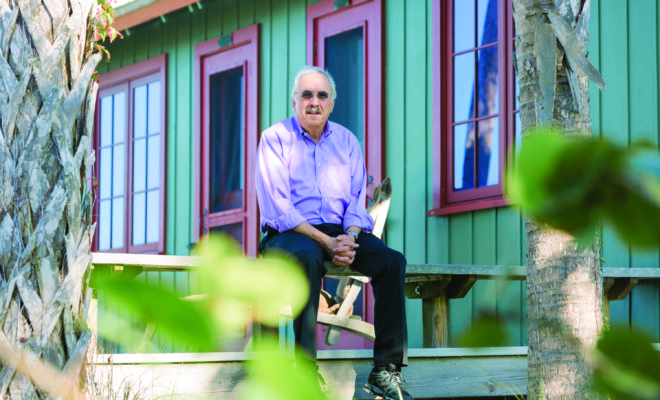
Feature
Nurturing The Innate Drive to Give Back
David Green and the Gulf Coast Community Foundation
By Sylvia Whitman | Photo by Nancy Guth
David Green’s friends tease him that he’s gone a bit “over-board.” He serves on six nonprofit boards and volunteers with several other social service entities. Now 74, Green retired a decade and a half ago as the senior global marketing officer for McDonald’s and instantly realized that “sitting at home was not an option.” As he says, “If you are a type A personality all your life, it is impossible to turn a switch and stop working and stop doing!”
Among his many projects, he’s the development chair for his beloved Sarasota Orchestra and helping to bring on a new executive director at the Hermitage artist retreat. Nearing the end of his second year on the Gulf Coast Community Foundation board, Green has signed on to three subcommittees—community investment, governance, and finance. “If I get involved,” he says, “I sort of jump in with both feet.”
Youngest son of a rabbi and a social worker, Green grew up in Shaker Heights, Ohio. Supporters of the nascent civil rights movement, his parents steered dinner-table conversations toward social justice issues—as well as the family’s next trip to a national park.
Green headed to Northwestern University intending to become a lawyer, but he “was soon drawn into the world of communications and marketing, spending long hours at the campus radio station.” After some starter jobs, he landed at McDonald’s, where he “introduced many iconic marketing campaigns, worked with some of the brightest agencies and minds in the business, developing Ronald McDonald House as a national and then international charity and making Happy Meals a cultural phenomenon.” McDonald’s, he says, “helped transform my life and ultimately gave me the resources to live a great life.” Now he’s plowing some of those rewards back into his two home communities: Bigfork, Montana, where he and his wife, Linda, spend five summer months near Glacier National Park, and Manasota Key in Englewood. (Given how often he drives up to Sarasota for board meetings, friends have quipped that he needs a pied-a-terre there as well.)
A Champion of Gulf Coast Community Foundation
Green has embraced Gulf Coast Community Foundation’s mantras of “better together” and “bold and proactive philanthropy.” While most nonprofits go deep on a single issue, he loves the foundation’s “wide palette and vista of transformative programs.” At any one time, Gulf Coast is working on five or six broad initiatives “as a catalyst behind the scenes, without a lot of fanfare,” says Green. Gulf Coast identifies a need and then brings the community together to address it, partnering with both local government and other nonprofits.
Recently Gulf Coast has focused attention and funding on homeless teens, hundreds of whom live in the Sarasota area. The foundation aims to understand their needs and coordinate existing resources available from agencies and the county to better serve them. Trouble is, homeless teens are a hard group to pin down. So Gulf Coast is facilitating communication with a place for them to meet and mentors, young and formerly homeless themselves, to act as interlocutors. “Then the kids feel, ‘Hey, they understand my problems,’” explains Green.
Green says he enjoys the board’s wide-ranging discussions and attention to how to maximize the foundation’s impact. “I have always been motivated by helping kids, helping schools, helping kids who are a bit lost to find themselves,” he says. Gulf Coast backs many education initiatives, from Reading Recovery (coaching first-graders who struggle with literacy) to STEMsmart (rejuvenating science education in middle and high schools, in part by upgrading classrooms). The foundation also underwrote a regional civility initiative that helped seed civility projects at schools and workplaces. “We’re trying to teach how to listen,” says Green, “which is so important in today’s political climate.”
Green sees mental health as another wide issue of consequence. With the Barancik Foundation, Gulf Coast commissioned a yearlong study of child and youth mental health. In economic terms, untreated mental illness in youth costs Sarasota County more than $86 million per year, the research found. Based on the report’s recommendations, the foundations convened agencies across the community to build a better system of care, and Gulf Coast has set up a fund for community donations to support that work. “The foundation is looking at what’s available, best practices across the U.S., what the community can provide—more counselors in schools, for instance, or more places to reach out if they have problems,” says Green.
“Philanthropy Is Most Rewarding When It’s a Contact Sport”
Gulf Coast’s cultivation of a culture of giving also excites Green. “Like a small consulting agency,” he says, the foundation works with nonprofits to increase their effectiveness, offering advice about how to create a strong board and a strong brand.
Gulf Coast also makes it easy for individuals to listen to their better angels. The foundation invites community members to join at whatever level they can in major projects. Legacy arrangements and donor-advised funds allow people to direct funds to nonprofits working on issues dear to their heart. Green is proud that both his sons, now in their 40s, give back in some way. One works for a nonprofit, Khan Academy; another, a filmmaker, participates in a program to recognize college screenplay writers. Green has also set up donor-advised funds for both “so they understand about getting involved and making a difference.”
His work on behalf of the Hermitage and Sarasota Orchestra echoes those themes. The Orchestra’s summer music camps, young person’s concerts and youth orchestra are all part of “trying to find ways to make sure that the next generation is prepared to make their contribution to society,” Green says. He also thrives on the challenge of building a much-needed new community music hall for the Orchestra and its youth activities.
The Hermitage, he adds, “is a good example of finding a hidden gem in the community that catches your imagination.” Green lives a few doors down from the rustic retreat but didn’t discover it until attending a weekend presentation by one of the visiting artists. “Because of the Hermitage,” Green says, “there is a piece of Sarasota artistic DNA in Pulitzer-Prize-winning works and hundreds of other works of art conceived there.”
Green credits nurture and nature for his own philanthropic drive. His parents instilled in him a love of the arts and the environment and a stake in civil rights, but he also had an inherent inclination, “getting immense joy and satisfaction from helping others.” Green believes all human beings, no matter how rough they might seem on the outside, share this altruism at the core. He points to stories of a stranger entering a burning house or a patron picking up a wounded veteran’s restaurant tab. “I believe that there is a deep part of us that wants to help, give back, and make our communities a better place to live,” he says.
As Gulf Coast Community Foundation celebrates its silver anniversary, Green is looking forward to more stimulating discussions and meaningful change. Personally, he’d like to see the organization home in on the criminal justice system, including how people released from prison integrate back into society. As he says, “How can you not feel a real sense of accomplishment, challenge, and reward when you are part of an organization that along with its donors has granted over $352 million in its short 25-year history?”
For more information about the Gulf Coast Community Foundation, visit www.gulfcoastcf.org or call 941.486.4600.




You must be logged in to post a comment Login